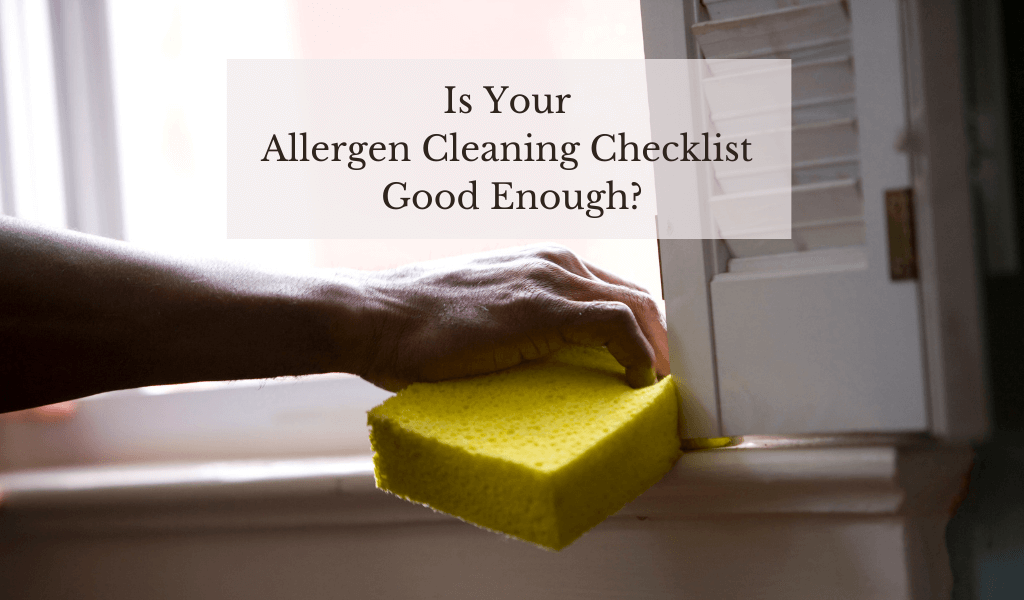Help your clients live in peace. Update your allergen cleaning checklist today, and your customers will thank you.
You have a cleaning checklist, but do you have an allergen cleaning checklist? If you have allergies, you’ve probably at least thought about it. Dust, mold, and pet allergies can cause sleepiness, headaches, sore throats, itchy or watery eyes, coughing, and a runny nose. Sensitivities to scents can trigger migraines, and certain chemicals may cause rashes or hives.
If you don’t have allergies, just know that they can lead to discomfort, pain, and even hospitalization in more severe cases. And let’s not forget that food allergens can be deadly. That’s especially important to consider if you’re working in food service areas as a commercial cleaner. From restaurants to cafeterias to food production spaces, preventing cross-contamination is incredibly important.
That seems like it might be a lot to cover on an allergen cleaning checklist. It’s not as intense as it appears, however. Much of your general cleaning checklist is applicable to allergen cleaning. You’ll still dust and wipe down sinks. You’ll still vacuum and mop. And in food service facilities, your checklist likely already includes sanitizing surfaces. To account for allergens, then, only requires a little more attention and a few potential updates to your cleaning checklist.
Learn how cleaning checklists from Janitorial Manager can help your team improve cleaning quality and increase client retention rates. Learn more today with a free discovery call and find out how to make your cleaning operation more efficient and cost effective!
It’s time to update your allergen cleaning checklist
Let’s start with food service areas, as that’s more straightforward in most cases. In fact, the FDA conveniently lays out the specifics for cleaning and sanitizing equipment. For example, they point out that any food contact surfaces and utensils should be sanitized by “immersion, manual swabbing, brushing, or pressure spraying methods” and that “contact times shall be consistent with those on EPA-registered label use instructions.”
If you really want to be on top of your game, though, add environmental allergen testing to your checklist. Test strips are designed to test for specific allergens, such as eggs, almonds, shellfish, gluten, and so on.
Now let’s get into allergen cleaning for other environments. Many of these may apply to food service spaces, as well, and include anywhere dust, mold, and other allergens can accumulate, from carpets to vents.
CMM points out that a carpet can act as “a reservoir of allergens,” and vacuuming can actually remove them from the carpet and suspend them in the air. CMM offers a couple of solutions to reduce allergens. Frequent dry vacuuming with equipment fitted with a HEPA filter and periodic wet vacuuming can help reduce the number of allergens in carpeting. However, don’t overdo the wet vacuuming, as damp carpet can be a breeding ground for mold.
Here are some other items to add to your allergen cleaning checklist.
- Fresh Air. Whenever possible, open windows to allow for fresh air circulation. Sunlight and fresh air have almost always been a great way to help clean indoor air. Why “almost always?”
- Beware of Outdoor Allergens. At certain times of the year, outside air can be loaded with allergens like pollen. Even though it’s a generally good idea to open windows and let fresh air in, that might not be the case when the pollen count is exceptionally high.
- Use Healthier Cleaning Products. Many chemicals and scented cleaners can actually trigger allergic reactions, so one item to add to your allergen cleaning checklist is to use non-toxic, unscented, green cleaning products.
- Don’t Let Allergens Get Airborne. CMM suggests using a damp cloth to “remove dust and allergens that accumulate on hard surfaces.”
- Change Air Filters Regularly. If it’s part of your contract, be sure to change HVAC filters on schedule. If it’s not already part of your contract, you might be able to suggest it as an add-on service.
- Use Damp Cloths. Damp cloths or wipes are “more effective in allergen removal from surfaces than dry wipes,” according to the FDA.
- Use a Color-Coded Cleaning System. A color-coded cleaning system helps prevent cross-contamination of allergens and other bacteria.
- Pay Special Attention to Doorways. Entrances and exits need extra attention on an allergen cleaning checklist, as so much dirt and bacteria get tracked in on shoes. Floor mats can help capture some of those allergens, but you still need to be consistent and thorough in keeping these areas clean.
- Educate Your Clients. Piles of papers and food crumbs can all harbor dust, dander, and other allergens. Help your clients understand how they can reduce allergens in their space with some behavioral changes.
Take your cleaning operation to the next level. Schedule a free call with Janitorial Manager to see how our software can make your janitorial operation more successful.

